Spider Solitaire vs. Solitaire: Differences in Rules and Strategy
By Neal Taparia - 08/14/2024
Spider Solitaire and Classic Solitaire share some of the same basics, such as only playing face-up cards or moving cards from the tableau to the foundation piles, but they also have several key differences like stockpile usage and sequencing rules.
Both games provide their own set of fun and unique challenges. Learning their rules and strategies will help you master them both and increase your win rate. Use this post to learn the ins and outs of each and then play Spider Solitaire or Classic Solitaire for free at Solitaired.com.
What’s the Difference Between Spider Solitaire and Classic Solitaire?
The chart below gives you a quick overview of the key differences between Spider Solitaire and Klondike Solitaire.
1. Goal
The object of both games is to move all of the cards to the foundation piles. However, the number of foundation piles and the way you move cards to the foundation piles differs.
Because Spider Solitaire uses 104 cards, you must complete eight foundation piles. Regular Solitaire only uses 52 cards, so it has four foundation piles.
In Spider Solitaire, you build same-suit sequences descending from king to ace in the tableau and move the completed sequences to your foundation piles.
In Klondike Solitaire, you move individual cards to each of the foundation piles by suit, ascending from ace to king. So, you will need to build sequences in the tableau to reveal hidden cards, and then move those individual cards up to the foundation piles.
2. Decks Used
The number of cards used impacts how difficult the game is. The more cards there are, the more cards you have to uncover and sequence.
In Spider Solitaire, you use 104 cards, and the number of suits you use depends on the version you’re playing. In Spider Solitaire 1 Suit, you use 104 cards of the same suit. If you play Spider Solitaire 2 Suits, you will play with four sets of two different suits, which is 52 cards of each suit. Finally, Spider Solitaire 4 Suits uses two sets of each suit or 26 cards of each of the four suits.
Using playing cards you’d need eight decks, four decks, and two decks respectively. However, you can play each version with two decks if you use your imagination. In 1 Suit, play all cards as if they are the same suit. In 2 Suit, categorize the cards by color (hearts and diamonds, spades and clubs). And in 4 Suit play each individual suit.
Solitaire is much simpler when it comes to decks used. A standard 52-card deck of playing cards is used to set up the game, although the jokers are removed.
3. Suits Used
Depending on the version of Solitaire and difficulty level, the number of suits you play with can vary.
In Spider Solitaire, you can choose the amount of suits you play with. If you’re playing with one suit, all the cards will be the same suit, which is easiest. Playing with two different suits increases the challenge, but you can play the most difficult version by using all four suits. No matter what version is used, the amount of cards will be 104.
On the other hand, Solitaire is always played with four suits.
While you can make either same-suit or mixed-suit sequences in Spider Solitaire 2 Suits and 4 Suits, you can only move same-suit sequences to foundation piles. So when you play Spider Solitaire versions that use more than one suit, you have to prioritize same-suit sequences when you play.
4. Tableau Setup
The tableau setup for Spider Solitaire games will be vastly different from Solitaire. However, most of the basic elements will be the same, except for the waste pile. Solitaire has one, but Spider Solitaire doesn’t use one.
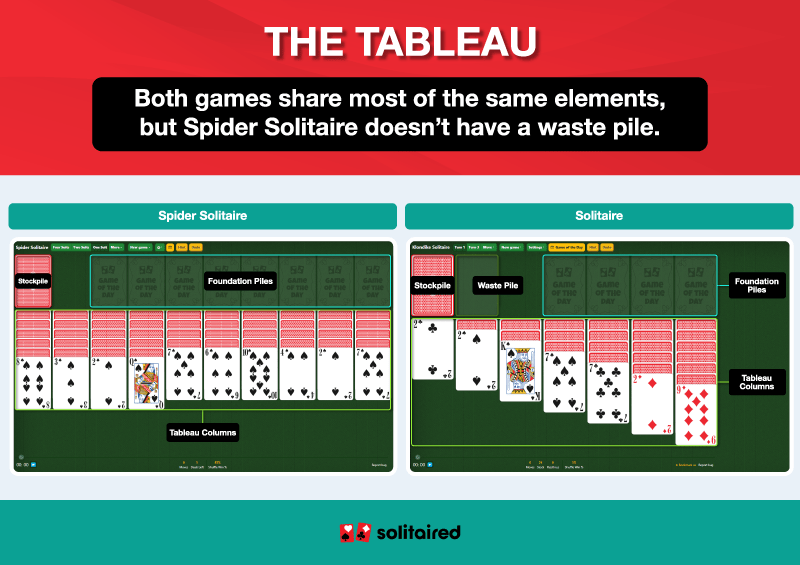
Here’s the basic setup for Spider Solitaire:
- Tableau: Start the game with all 104 cards. The tableau includes ten columns, with the first four columns containing six cards and the next six columns containing five cards. All of the cards should be facedown, except for the first card at the end of the column.
- Stockpile: Now, you should be left with 50 cards that will be used as the stockpile. You utilize the stockpile when you’ve run out of moves on the tableau.
- Foundation piles: Leave space at the top of the tableau for foundation piles. You’ll use eight foundation piles to move your completed sequences from king to ace.
Here’s how to set up Solitaire:
- Tableau: You only need one deck of 52 playing cards. You need to deal seven columns of cards from left to right. The first column has one card, the second column has two, and so on. The last card in the column needs to be face up.
- Stockpile: You’re left with 24 cards for the stockpile. Use these when you run out of moves.
- Waste pile: This is where you’ll place cards from the stockpile face up. If playing Turn 1, you flip one card face up on the waste pile, but with Turn 3, you flip three cards face up on the waste pile.
- Foundation piles: You need space at the top for only four foundation piles. You move cards to them individually, sequencing them in ascending order from ace to king to ace by suit.
With lots of columns and cards in Spider Solitaire, you can make more moves, but it also means you have several more cards to reveal, sequence, and then move to the foundation piles. In Solitaire, you have the waste pile, which gives you one more face-up card to play. Not having one in Spider Solitaire means you need to watch how you play to avoid getting stuck on the tableau.
5. Number of Foundation Piles
There are eight foundation piles in Spider Solitaire and four foundation piles in Solitaire. The reason for the doubling of the foundation piles is that Spider Solitaire has double the amount of cards.
No matter what version of Spider Solitaire you play, you will still have eight foundation piles. These are always sorted by suit and descend from king to ace.
In Solitaire, you use four foundation piles. Like Spider, they’re organized by suit, but they will ascend from ace to king.
Since the number of piles corresponds to the number of cards you use, the strategy of sequencing cards won’t differ. However, since you’re dealing with twice the amount of cards in Spider, you will have to do double the amount of work and fill twice the amount of foundation piles.
6. Sequencing Cards
The biggest difference between Spider Solitaire and regular Solitaire is how you build and move sequences.
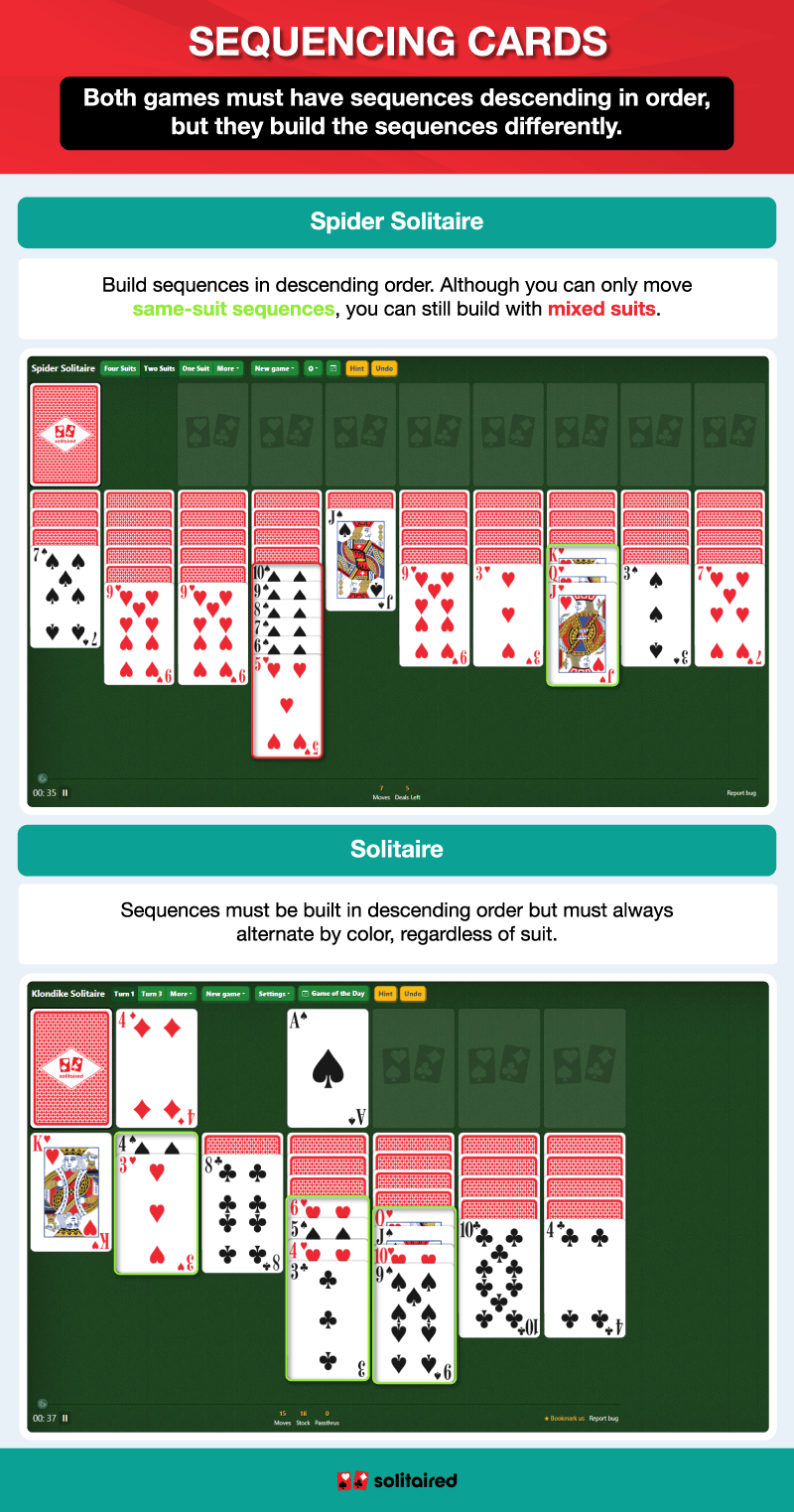
To best understand how to play Spider Solitaire, you have to know how sequences are built. You must build completed sequences before they can move to the foundation piles. Sequences have to be built in descending order. You can build mixed-suit or same-suit sequences. However, you’re only able to move sequences of the same suit up to the foundation piles.
The key difference between how to play Solitaire and Spider Solitaire is that in Solitaire you build sequences of alternating color, but you move one card to the foundation pile at a time. For example, a jack of spades can be placed on a queen of diamonds, but you will only move one of those cards at a time to their foundation piles.
When playing Solitaire, you will want to build as many mixed-suit sequences as possible to reveal facedown cards and move cards to the foundation piles. However, in the game of Spider Solitaire, you should limit the number of mixed-suit sequences you make, since you can only move completed same-suit sequences to foundation piles.
7. Moving Cards to Foundation Piles
In both of these Solitaire variants, the object of the game is to move all the cards from the tableau to the foundation piles. However, the games are very different in how the piles are completed.
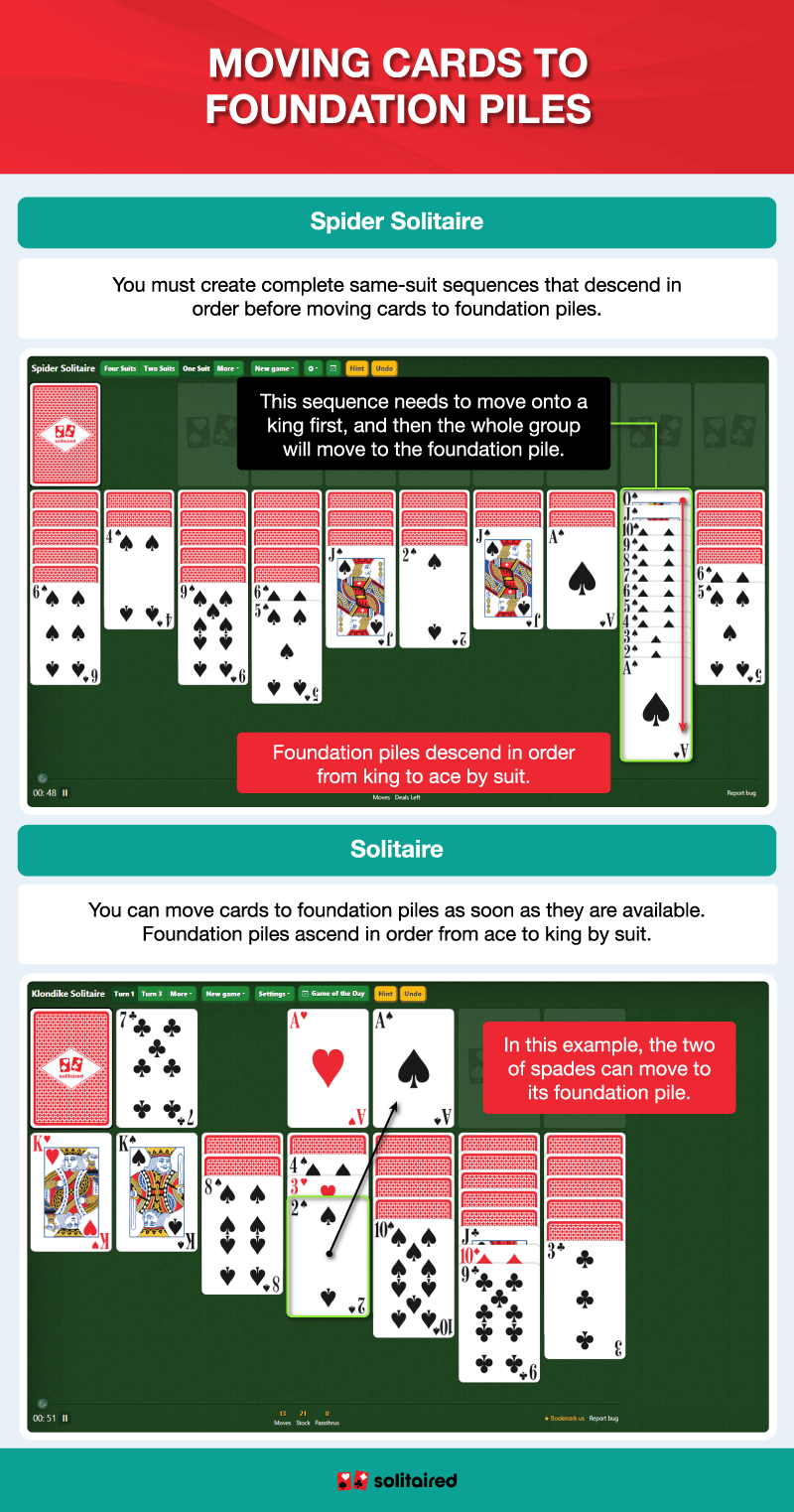
To move cards in Spider Solitaire, you must complete a same-suit sequence that descends in order in the tableau before it can be moved into a foundation pile.
When playing Solitaire, you move one card at a time to their respective foundation piles. These piles ascend from ace to king by suit. As long as the card you want to move is face up, it can be moved up into the pile.
Moving individual cards in Solitaire allows you to reveal facedown cards or make available other cards in the sequences so they can be moved to foundation piles. You’ll need to strategize on how many cards you move to the piles, however, as moving too much of one suit will take away useful cards you need to build sequences in the tableau. This changes when it comes to Spider Solitaire. With Spider, you need to focus on building full sequences so that you can move them to the foundation piles.
8. Use of Stockpile
The stockpile can be useful because it can give you new cards to play. However, because it functions so differently in each game, knowing how best to utilize it will help you avoid blocking your gameplay.
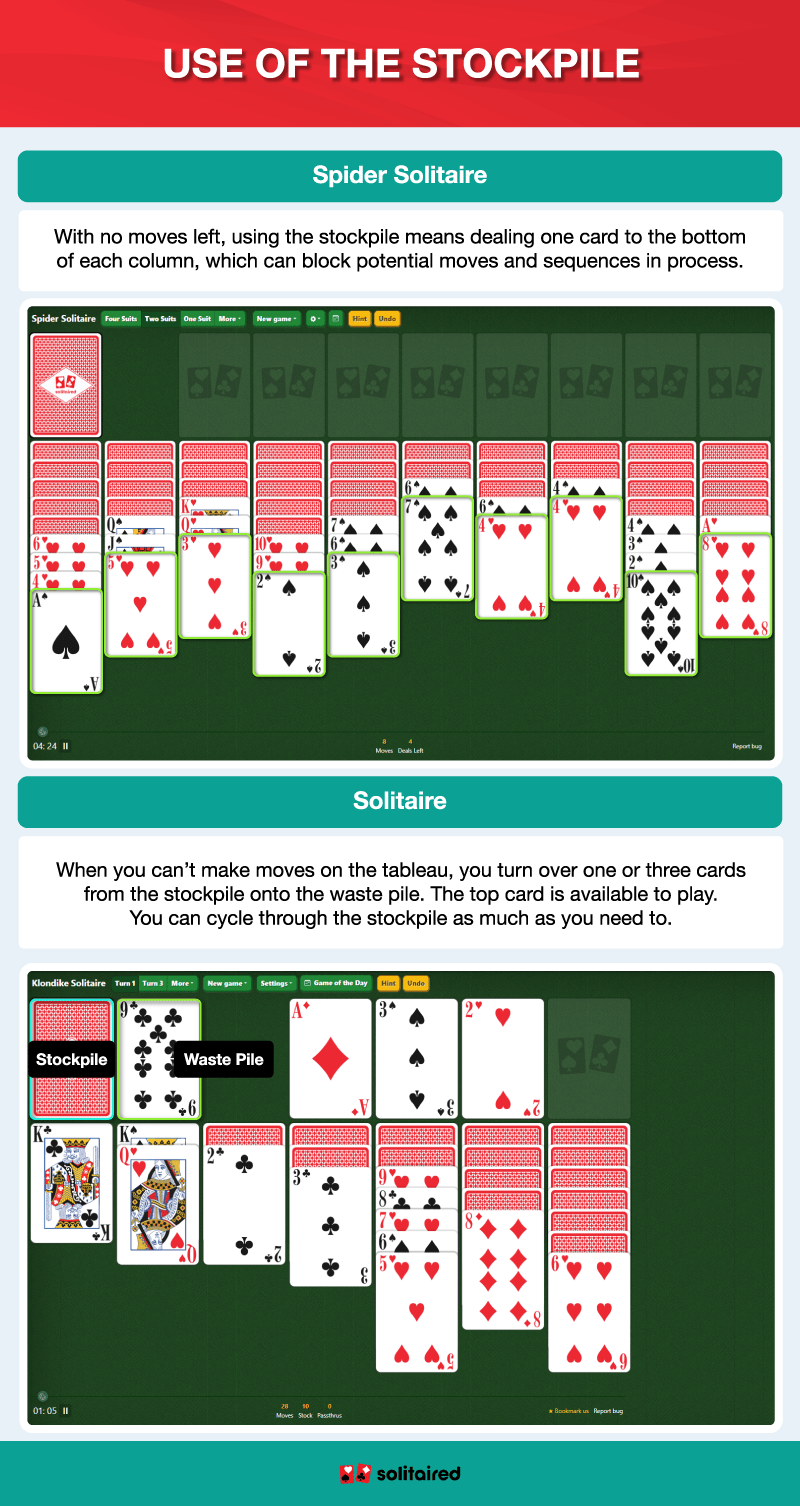
In Spider Solitaire, you deal one face-up card to the bottom of each column when you use the stockpile. This means you could be blocking useful cards and sequences you’ve built. Before you use the stockpile, you must also be sure that each column has a card in it, which means using up an empty column that you may have kept empty on purpose. Since the stockpile has only 50 cards, you will only be able to use the stockpile five times.
When you play Solitaire, you’re able to turn over one card or three cards from the stockpile onto the waste pile, depending on the version you play. You can only use the top face-up card, but you can continually cycle through the stockpile until you’ve played all the cards from it.
You can cycle through the stockpile as many times as you like in Solitaire, but you can only use it five times in Spider Solitaire. So while you can freely use the stockpile in Classic Solitaire, it should be the last-resort option in Spider Solitaire because using the stockpile could cause you to block a card you need or to run out of stockpile cards.
9. Use of Empty Columns
Empty columns give you more room to play cards, but Classic Solitaire limits your moves with empty columns.
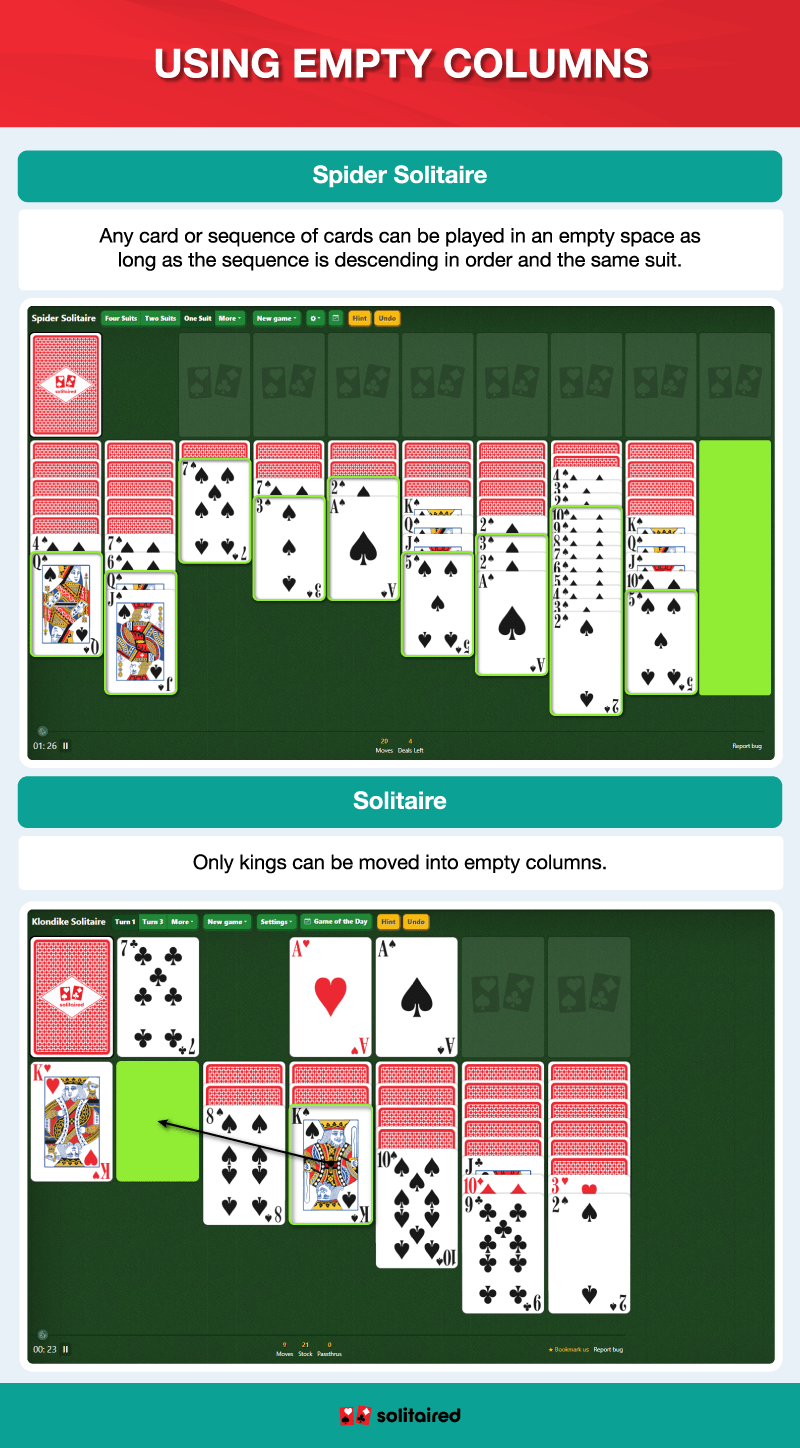
In Spider Solitaire, you can move any card or same-suit sequence of cards into an empty column. This is helpful if you have a sequence that’s blocking a card you might need. Empty columns can also help you undo mixed-suit sequences and act as a temporary sequence-building location.
In Solitaire, you can only place a king in an empty column. This means only four cards (each of the four kings) can go into any column you empty.
Since you can only move a king into a column in Solitaire, you shouldn’t focus too much with emptying columns unless you need to use the cards or reveal cards. However, empty columns in Spider Solitaire give you an extra spot to play. You can also further the amount of future moves you can make by placing a high-ranking card into the empty column.
10. Difficulty Level
If you know how to play Solitaire, you can increase the challenge with Spider Solitaire, which is typically harder, but each type of Solitaire has versions that vary in difficulty.
You play with two decks in Spider Solitaire, so you have more cards to reveal and move to foundation piles, which makes the game harder. You can make it even more difficult by adding more suits. The more suits you play with, the harder the game of Spider Solitaire is.
Solitaire has fewer cards for you to reveal and move to foundation piles, so it’s considered easier than Spider Solitaire. You can make the game harder by playing Turn 3 Solitaire instead of Turn 1. In Turn 3, you turn over three cards from the stockpile and play the top one. This is harder as you have the two cards underneath that you won’t be able to play unless you free the top card.
11. Versions
Both Spider Solitaire and Solitaire have different versions that increase the challenge.
Spider Solitaire has three versions: 1 Suit, 2 Suits, or 4 Suits. As the name suggests, you play with only one suit in Spider Solitaire 1 Suit, which is the easiest. The challenge increases as you add suits. In Spider Solitaire 2 Suits, you play a more moderately difficult version with two suits to arrange and sequence. With 4 Suits, you play with four different suits, which is the most difficult version.
Solitaire has two versions: Turn 1 or Turn 3. The numbers describe how many cards you turn over when using the stockpile. Since Turn 1 allows you to use one card from the stockpile at a time, it’s considered easier because you can reveal and play each card in the stockpile. However, Turn 3 only allows you to flip three cards at a time, and you’ll only be able to reach the hidden cards by playing the top card.
If you’d like to see the differences between Solitaire and Spider Solitaire for yourself, try playing for free without downloads on Solitaired.com. You’ll find many other popular single-player games like FreeCell and Pyramid, and you can play them all for free without having to make an account.
About the author

